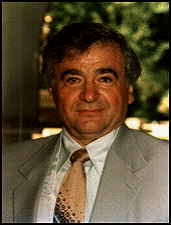Welcome to WiMob 2009
WiMob 2009 will be held in Marrakech, Morocco, on October 12th-14th, 2009

 Tutorial 1:
Tutorial 1:
"Mobile Peer-to-Peer Networks for Vehicular Applications"
Prof. Mario Gerla – UCLA – California - USA.
Abstract:
Peer-to-peer (P2P) systems have met enormous success in the Internet because of the many advantages they offer with respect to traditional client/server systems, namely: scalability, dependability and robustness. Peer to Peer systems are now emerging also in wireless, mobile networks. For example: vehicle and people based content distribution, file sharing and network games; urban environment sensing with vehicles or personal cellular phones; collaborative group-work in people networks, etc. Mobility and radio propagation pose formidable challenges to mobile P2P architectures, requiring a fundamental redesign with respect to traditional P2P strategies.
In this tutorial we address the vehicular scenario, a scenario that has attracted growing interest for the range of applications it enables, from safe driving to content distribution, advertising, commerce and games. We first introduce basic P2P models for fixed and mobile networks. Then, we review popular Vehicle to Vehicle (V2V) applications supported by the P2P dissemination paradigm (Car/CodeTorrent, Mobeyes and Last Encounter Routing). Finally, we discuss the design challenges including information harvesting and privacy
Outline:
Part I : Basic P2P models
- Internet Overlays: Multicast
- DHT Indexing: Chord, Pastry
- A Mobile DHT: VRR
Part II: Vehicular Applications
- Mobility models
- Content Distribution: CarTorrent; CodeTorrent; Network Coding
- Dissemination: Urban Sensing, Mobeyes
- Last Encounter routing – a routing scheme supported by P2P dissemination
- Secure dissemination: Situation Aware Trust (SAT)
Biography of Prof. Mario Gerla
Dr. Mario Gerla, Professor, UCLA, Computer Science Dept. Dr. Gerla received his Engineering degree from the Politecnico di Milano, Italy, in 1966 and the M.S. and Ph.D. degrees from UCLA in 1970 and 1973. He became IEEE Fellow in 2002. At UCLA, he was part of a small team that developed the early ARPANET protocols under the guidance of Prof. Leonard Kleinrock. He worked at Network Analysis Corporation, New York, from 1973 to 1976, transferring the ARPANET technology to several Government and Commercial Networks. He joined the Faculty of the Computer Science Department at UCLA in 1976, where he is now Professor. At UCLA he has designed and implemented some of the most popular and cited network protocols for ad hoc wireless networks including distributed clustering, multicast (ODMRP and CODECast) and transport (TCP Westwood) under DARPA and NSF grants. He has lead the $12M, 6 year ONR MINUTEMAN project, designing the next generation scalable airborne Internet for tactical and homeland defense scenarios. He is now leading two advanced wireless network projects under ARMY and IBM funding. In the commercial network scenario, with NSF and Industry sponsorship, he has led the development of vehicular communications for safe navigation, urban sensing and location awareness. A parallel research activity covers personal P2P communications including cooperative, networked medical monitoring (see www.cs.ucla.edu/NRL for recent publications).
------------------------------------------------------------------------------------------------------------------------------------------------------

Tutorial 2:
"A Novel Approach in the Design of Secure Wireless Systems Using ChaoticSignals and Iinterference Mitigation Techniques"
Prof. Peter Stavroulakis
Technical University of Crete
Chania , Crete , Greece
Abstract:
One can say that the subject of security is as old as the subject of communications. The field of wireless communications has become one of the primary media for transmitting information from point to point and from a point to a given area. The advent of Satellite communications technology and its application to satellite mobile systems has made the subject of security of universal concern in the design of wireless systems.
In this tutorial we shall present a review of the areas that require further study regarding the factors that affect the security of wireless systems and we will show for the first time why the existing security mechanisms including cryptography do not necessarily solve the security problems in various wireless systems. We shall propose ways to move forward using as an example a new methodology based on Chaotic techniques. This methodology is based on two recent books and an International Patent by the author by which what was thought as an impossible task i.e to make chaotic signal based secure communications robust is now proved possible.
Scope and Objective
The scope of this tutorial is to show how a novel approach in designing secure wireless systems based on the reevaluation of older techniques could be implemented in realistic applications. It is expected that this tutorial will generate some renewed interest in the application of chaotic signals in the design of modern secure wireless systems.
Intended Audience
This tutorial will be valuable to all researchers interested in the general field of security and young scientists who are looking for new research topics in the field of security. As a matter of fact this tutorial is also proposing a new open research areas.
Attending this Tutorial, the participants will be able to get an overall outline of how the security field has been developed and where we still need to do some more work and how we can move forward covering the remaining gaps which basically relate interference mitigation techniques with chaotic signal based secure communications. Some specific real world applications will be presented which have direct implementability.
In summary, this Tutorial will benefit young researchers, designers of large scale Secure Telecom Systems such as those used in World class events as are the Olympic Games and University Instructors who are seeking to put together instruction material for new courses and /or choose research topics for their Ph.D students.
Outline:
This Tutorial will cover the following topics:
- What is Security/Security Mechanisms
- Security aspects of OSI Model
- Mapping of the seven layer ISO Model to a
Seven level security Model
- Present Status of Secure Wireless Systems
- Use of Chaotic Signals to enhance security
in conjunction with Interference Mitigation
- Application to TETRA Systems.
- Proposals for TETRA based Secure Systems
- Applications in space security
Biography of Prof Peter Stavroulakis
Peter Stavroulakis received his BS and Ph.D. degrees from New York University in 1969 and 1973 respectively and his MS degree from California Institute of Technology in 1970.He joined Bell Laboratories in 1973 and worked until 1979 when he joined Oakland University in Rochester Michigan as an associate Professor of Engineering. He worked at Oakland University until 1981 when he joined ATT International and subsequently NYNEX International until 1990. From1990 to present he has been at Technical University of Crete. as a full Professor of Electrical Engineering in may 1990. His related work includes more than 100 research papers. He is the author/editor in total of 14 Books in the general Area of Telecommunication Systems.
His Distinct Qualifications related to security are the following:
1) Participated in the design of the Security Network for the Winter Olympic Games in 1986 at Albertville France and was responsible for the evaluation of the security Network for the Athens Olympic/2004
2) He is a Holder of a unique International Patent on the security of wireless Communications based of Chaotic Techniques.
3) Author of two related books published by ARTECHOUSE and Taylor and Francis and two other books by SPRINGER one of which is just being published.
4) He had been invited by China to participate in similar activities regarding the Olympic Games of Beijing/2008 and he is a Member of Editorial Board of the China Communications Journal. He co-organized a Conference in Beijing in October 2006 to present how these concepts can be used for the Beijing Olympics/2008. He was also invited by the governing board of CHINACOM to present an All Day Tutorial in October 2006 in Beijing on the subject of Network and Information Security. He has also served as a Guest Editor for the CHINA COMMUNICATIONS JOURNAL for two special issues on Communications and Information security.
5 )He is a founding member of the IEEE Technical committee on Communication and information security and has received the sponsorship of this committee for proposing the establishment a new IEEE Transaction Journal on Communication and Information security.
Professor Peter Stavroulakis has presented a number of successful tutorials in related subjects in the last five years in IEEE conferences such as ICC, Globecom, and VTC conferences



